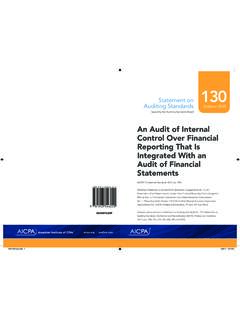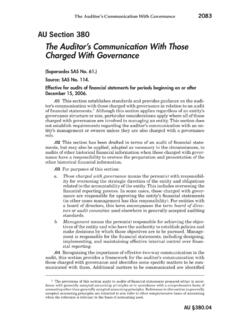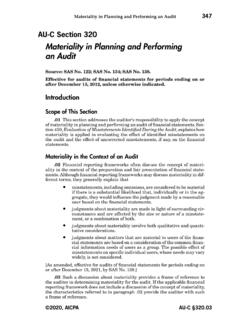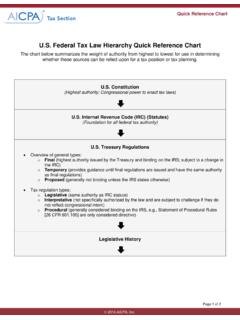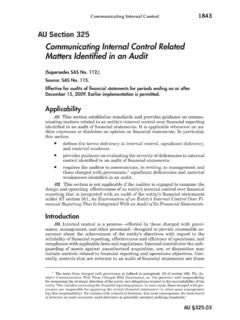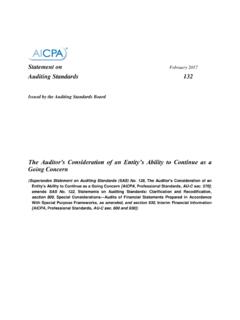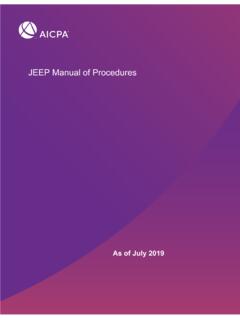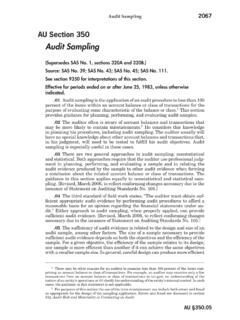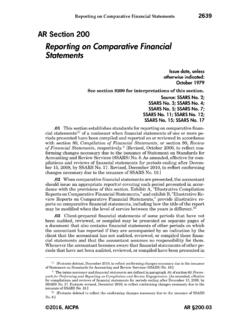Transcription of SM Report with the Criteria in the Cloud Security Alliance ...
1 April 2014. Financial Reporting Center Illustrative Type 2 SOC. 2SM Report with the Criteria in the Cloud Security Alliance (CSA). Cloud Controls Matrix (CCM). The aicpa guide Reporting on Controls at a Service Organization Relevant to Security , Availability, Processing Integrity, Confidentiality, or Privacy (SOC 2SM) specifies the components of a SOC 2SM. Report and the information to be included in each component, but it does not specify the format for these reports. Service organizations and service auditors may organize and present the required information in a variety of formats. The format of the illustrative type 2 SOC 2 Report presented in this document is meant to be illustrative rather than prescriptive. The illustrative Report contains all of the components of a type 2 SOC 2 Report ; however, for brevity, it does not include everything that might be described in a type 2 SOC 2 Report .
2 Ellipses (..) or notes to readers indicate places where detail has been omitted. The trust services principle(s) being reported, the controls specified by the service organization, and the tests performed by the service auditor are presented for illustrative purposes only. They are not intended to represent the principles that would be addressed in every type 2 SOC 2 engagement, or the controls, or tests of controls, that would be appropriate for all service organizations. The trust services principles on which the Report is based, the controls a service organization would include in its description, and the tests of controls a service auditor would perform for a specific type 2 SOC 2. engagement will vary based on the specific facts and circumstances of the engagement.
3 Accordingly, it is expected that actual type 2 SOC 2 reports will address different principles and include different controls and tests of controls that are tailored to the service organization that is the subject of the engagement. The Cloud Security Alliance (CSA) Cloud Controls Matrix (CCM) Version is used for the purpose of this illustrative Report . The CSA periodically issues new Criteria . The practitioner should identify the CCM version being used as Criteria in management's assertion and the service auditor's Report . Trust Services Principles, Criteria , and Illustrations for Security , Availability, Processing Integrity, Confidentiality, and Privacy (2009) is used for the purpose of this illustrative Report . The aicpa . periodically issues new Trust Services Principles and Criteria .
4 The practitioner should identify the current Trust Services Principles and Criteria version for management's assertion and the service auditor's Report . Illustrative Type 2 SOC 2SM Report : Reporting on the Security and Availability of a System Using the Criteria for Security and Availability in Section 100A, Trust Services Principles, Criteria , and Illustrations for Security , Availability, Processing Integrity, Confidentiality, and Privacy ( aicpa , Technical Practice Aids) and on the Controls of a System Using the Criteria in the Cloud Security Alliance Cloud Controls Matrix In the following illustrative type 2 SOC 2 Report , the service auditor is reporting on the fairness of the presentation of the service organization's description of its system based on the description Criteria identified in management's assertion.
5 And the suitability of the design and operating effectiveness of its controls relevant to Security and availability based on the Criteria for Security and availability in TSP Section 100A, Trust Services Principles, Criteria , and Illustrations for Security , Availability, Processing Integrity, Confidentiality, and Privacy ( aicpa , Technical Practice Aids) and, the suitability of the design and operating effectiveness of its controls in meeting the Criteria in the CCM. Description of Example Cloud Service Organization's Infrastructure Services System Relevant to Security and Availability For the Period January 1, 20XX, through December 31, 20XX, with Independent Service Auditor's Report including Tests Performed and Results Thereof Section 1 Management of Example Cloud Service Organization's Assertion Regarding its Infrastructure Services System Throughout the Period January 1, 20X1, to December 31, 20X1.
6 Section 2 Independent Service Auditor's Report Section 3 Example Cloud Service Organization's Description of its Infrastructure Services System Throughout the Period January 1, 20X1, to December 31, 20X1. System Overview and Background Infrastructure Software People Procedures Data Customer Responsibilities A. Relevant Aspects of the Control Environment, Risk Assessment Process, Information and Communication Systems, and Monitoring B. Policies and Procedures C. Communication D. Physical Security E. Logical Security F. Monitoring G. Relationship between CCM Criteria , Description Sections, and Trust Services Criteria Section 4 Applicable Trust Services Principles, Criteria , and CCM Criteria and Related Controls, Tests of Controls, and Results of Tests Section 5 Other Information Provided by Example Cloud Service Organization Not Covered by the Service Auditor's Report Language shown in boldface italics represents modifications that would be made to the service auditor's Report if complementary user-entity controls are needed to meet certain applicable trust services Criteria .
7 Section 1 Management of Example Cloud Service Organization's Assertion Regarding its Infrastructure Services System Throughout the Period January 1, 20X1, to December 31, 20X1. We have prepared the description in the section titled, Example Cloud Service Organization's Description of its Infrastructure Services System Throughout the Period January 1, 20X1, to December 31, 20X1, (description), based on the Criteria for a description of a service organization's system identified in paragraph of the aicpa guide Reporting on Controls at a Service Organization Relevant to Security , Availability, Processing Integrity, Confidentiality, or Privacy (SOC 2SM) (description Criteria ). The description is intended to provide users with information about the Infrastructure Services System, particularly system controls intended to meet the Criteria for the Security and availability principles (applicable trust services Criteria ) set forth in TSP section 100A, Trust Services Principles, Criteria , and Illustrations for Security , Availability, Processing Integrity, Confidentiality, and Privacy ( aicpa , Technical Practice Aids), and the Criteria set forth in the CSA Cloud Controls Matrix (CCM) Version control specifications (CCM criteria1).
8 We confirm, to the best of our knowledge and belief, that a. the description fairly presents the Infrastructure Services System throughout the period January 1, 20X1, to December 31, 20X1, based on the following description Criteria : i. The description contains the following information: (1) The types of services provided (2) The components of the system used to provide the services, which are the following: (a) Infrastructure. The physical and hardware components of a system (facilities, equipment, and networks). (b) Software. The programs and operating software of a system (systems, applications, and utilities). (c) People. The personnel involved in the operation and use of a system (developers, operators, users, and managers). (d) Procedures.
9 The automated and manual procedures involved in the operation of a system (e) Data. The information used and supported by a system (transaction streams, files, databases, and tables). (3) The boundaries or aspects of the system covered by the description (4) How the system captures and addresses significant events and conditions (5) The process used to prepare and deliver reports and other information to user entities or other parties (6) If information is provided to, or received from, subservice organizations or other parties, (a) how such information is provided or received and the role of the subservice organization or other parties, and (b) the procedures performed to determine 1. The control specifications included in the CCM constitute suitable Criteria , as defined in paragraph 24 of AT.
10 101, Attest Engagements ( aicpa Professional Standards). Omission of one or more of the Criteria is likely to result in Criteria that are not suitable because they are not complete. The CSA periodically issues new Criteria . The practitioner should check the CSA website for current applicable Criteria and identify the CCM version being used as Criteria in management's assertion and the service auditor's Report . that such information and its processing, maintenance, and storage are subject to appropriate controls2. (7) For each principle being reported on, the applicable trust services and CCM Criteria and the related controls designed to meet those Criteria , including, as applicable, (a) complementary user-entity controls contemplated in the design of the service organization's system, and (b) when the inclusive method is used to present a subservice organization, controls at the subservice organization3.
